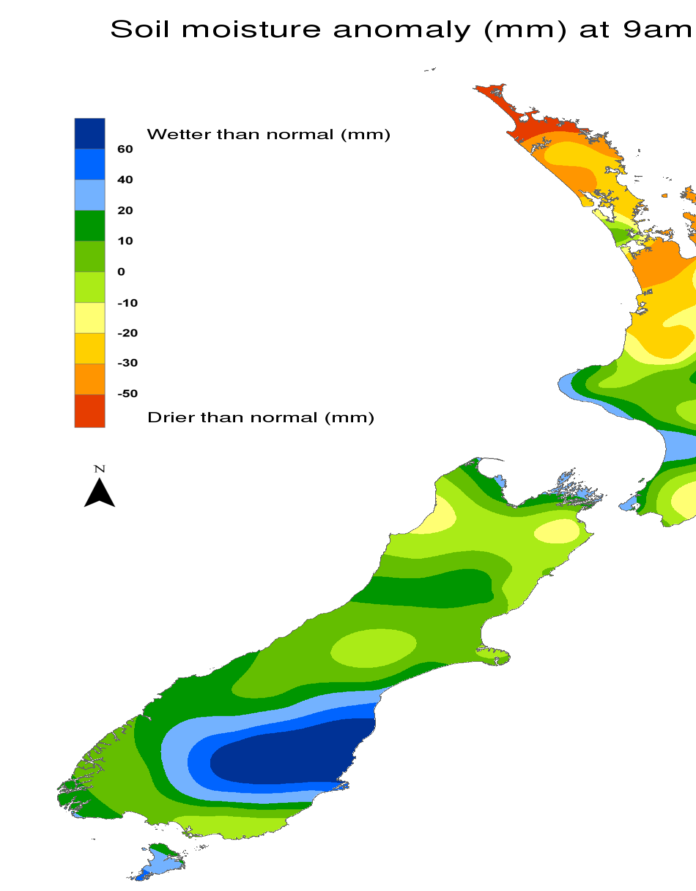Source: NIWA – National Institute of Water and Atmospheric Research
A weekly update describing soil moisture patterns across the country to show where dry to extremely dry conditions are occurring or imminent. Regions experiencing significant soil moisture deficits are deemed “hotspots”. Persistent hotspot regions have the potential to develop into drought.
Facts: Soil Moisture
Significant rainfall was observed in much of the upper North Island during the past week, with many locations receiving 30-60 mm. Similar amounts were also observed in parts of Manawatu-Whanganui. Elsewhere, much of the east coast and lower South Island saw less than 20 mm during the past week. This resulted in moderate to large soil moisture increases in the central and upper North Island, with smaller increases in eastern areas. The driest soils across the North Island, when compared to normal for this time of the year, are now found in the Far North and Aupouri Peninsula. Meanwhile, the wettest soils for this time of the year are located in coastal Taranaki and Manawatu-Whanganui, as well as eastern Bay of Plenty.
Hotspots are currently in place in East Cape, northern Waikato (including much of the Coromandel Peninsula), southern Auckland, and much of Northland. The New Zealand Drought Index (NZDI) map below shows that meteorological drought has emerged in the Aupouri Peninsula, with widespread dry to extremely dry soils in the rest of Northland, Auckland, and northern Waikato.
Heavy rainfall was observed in much of the western and lower South Island during the past week, with many areas receiving 75 mm or more, and isolated amounts of 150 mm. However, substantially less rain fell in the upper South Island as well as northern and central Canterbury, where amounts were generally less than 20 mm. This resulted in large soil moisture increases in western and southern areas, while the upper South Island saw minor soil moisture decreases. The driest soils in the South Island compared to normal for this time of the year are located in small portions of Marlborough and Buller District, while the wettest soils for this time of the year are found in southern Canterbury and much of Otago.
No hotspots are currently found in the South Island.
Outlook and Soil Moisture
Much of the next week’s rain will fall today (8 January), with areas of heavy morning rain in the upper North Island, and widespread showers and thunderstorms in the central and eastern North Island that will produce locally heavy rainfall in excess of 40 mm. Thereafter, high pressure will be in control of the North Island’s weather through the end of next week, resulting in mostly dry weather. These days may feature isolated afternoon showers and thunderstorms, but rainfall will be very localised.
Upper and eastern parts of the North Island may see small soil moisture decreases during the next week, with larger decreases possible in western and southern areas where rainfall totals are likely to be minimal. This could result in slight strengthening and expansion of all current hotspots in the upper North Island and East Cape.
High pressure will generally be in control of the South Island’s weather over the next week, with only a handful of weak troughs moving across southern portions of the island in coming days. This will result in weekly rainfall totals being 15 mm or less for most South Island locations.
Due to expected rainfall, at least small soil moisture decreases will be likely across most of the South Island during the next week. There is a small chance that a new hotspot will form in Marlborough during this time.
Background:
Hotspot Watch: a weekly advisory service for New Zealand media. It provides soil moisture and precipitation measurements around the country to help assess whether extremely dry conditions are imminent.
Soil moisture deficit: the amount of water needed to bring the soil moisture content back to field capacity, which is the maximum amount of water the soil can hold.
Soil moisture anomaly: the difference between the historical normal soil moisture deficit (or surplus) for a given time of year and actual soil moisture deficits.
Definitions: “Extremely” and “severely” dry soils are based on a combination of the current soil moisture status and the difference from normal soil moisture (see soil moisture maps).
Hotspot: A hotspot is declared if soils are “severely drier than normal” which occurs when Soil Moisture Deficit (SMD) is less than -110 mm AND the Soil Moisture Anomaly is less than -20 mm.
]” title=””>
]” title=””>
Pictured above: Soil Moisture Anomaly Maps, relative to this time of year. The maps show soil moisture anomaly for the past two weeks.
New Zealand Drought Index (NZDI)
As of 6 January, the New Zealand Drought Index (NZDI) map below shows that meteorological drought has emerged in the Aupouri Peninsula, with widespread dry to extremely dry soils in the rest of Northland, Auckland, and northern Waikato. Please note: some hotspots in the text above may not correspond with the NZDI map. This difference exists because the NZDI uses additional dryness indices, including one which integrates the rainfall deficit over the past 60 days. Changes are therefore slower to appear in the NZDI compared to soil moisture anomaly maps that are instantaneously updated.
]” title=””>



